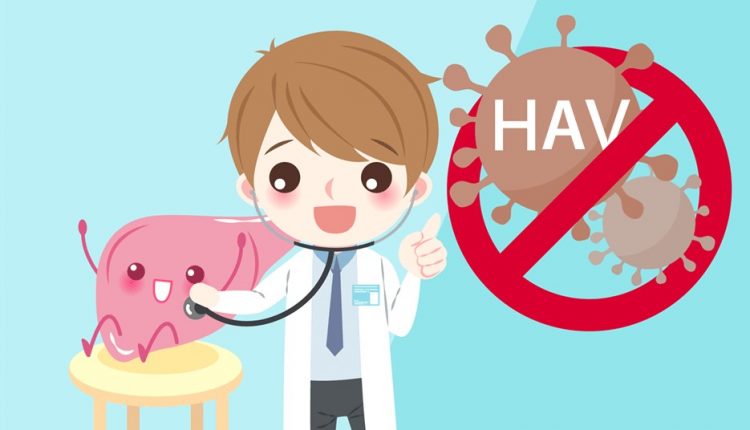
Hepatitis A: what it is and how it is transmitted
Hepatitis A (HAV) is a highly contagious infectious liver disease caused by an RNA virus that attacks liver cells
It is present in the blood of infected persons for only a few days while in the faeces it is present 7-10 days before the onset of symptoms and up to a week after the disappearance.
It is transmitted through food and drink or by contact with infected persons and differs from Hepatitis B and Hepatitis C in that it generally has a spontaneously benign course and never becomes chronic, so there is no chronic carrier status for the virus in either blood or faeces.
Complications are rare, however, severe forms with a protracted course and fulminant and lethal forms can occur.
Hepatitis is widespread throughout the world, in both sporadic and epidemic forms, particularly in underdeveloped or developing countries where there are poor sanitary conditions.
In Italy, the disease is endemic especially in the southern regions where consumption of raw seafood is most common.
Signs and symptoms of Hepatitis A
In 70% of cases, Hepatitis is completely asymptomatic, but when symptoms are present they appear approximately 15-45 days after contact with the virus and tend to disappear spontaneously within 2 months.
The most frequent symptom of hepatitis is asthenia, i.e. severe weakness.
Other symptoms usually reported by patients with this hepatitis are loss of appetite, abdominal pain, nausea and vomiting, fever, headache, muscle pain, jaundice (i.e. the appearance of a yellowish discolouration of the skin and eye sclerae), elevated transaminase and bilirubin values.
Itching, pale stools and dark urine may also appear as the disease progresses.
In epidemics and in children it may be completely asymptomatic.
Causes and transmission of Hepatitis A
In most cases, the disease is due to faecal contamination of food and water.
The most common causes of transmission of the Hepatitis A virus are:
- poor personal hygiene and failure to observe hygiene rules when preparing food
- unprotected sexual intercourse (in particular anal or ano-lingual sex)
- consumption of contaminated raw or undercooked water or food (especially fish from sewage-polluted waters)
- use of used syringes for injecting drugs
- contact with people with this form of hepatitis in the acute phase in personal hygiene situations (e.g. changing nappies and diapers).
Who is at risk of contracting the Hepatitis A virus
Although anyone can contract hepatitis, certain categories of people are at greater risk of coming into contact with the hepatitis A virus.
These include:
- people with chronic liver disease
- travellers to countries where hepatitis A is endemic (South-East America, Central America, Mexico, the Caribbean, Eastern Europe, South-East Asia)
- drug addicts
- those practising unprotected sex (particularly with multiple partners)
- people working in environments where contact with the virus is possible (e.g. in laboratories) or cohabiting with or caring for people with Hepatitis A.
Diagnosis of Hepatitis A
Diagnosis is made by searching for specific antibodies against the virus by means of blood tests:
- HAV-Ab IgM antibodies indicate acute infection and disappear after recovery.
- HAV-Ab IgG antibodies indicate past infection, remain positive throughout life and prevent future reinfection.
Hepatitis A therapies
It is usually not treated with drugs because the symptoms are mild and the disease resolves spontaneously.
Only rarely does it require hospitalisation to keep liver function under control and to provide special care for the patient.
How to prevent Hepatitis A
To prevent contagion, it is necessary to take scrupulous care of personal hygiene and food handling and preparation, and to have protected sexual intercourse; to inform the partner of the infection and recommend a test.
The vaccine, on the other hand, is recommended for people at risk.
It is an inactivated virus that is administered intramuscularly into the upper arm.
To prevent this hepatitis, all children after the age of one and transplant patients or those awaiting a transplant can be vaccinated.
Read Also:
Emergency Live Even More…Live: Download The New Free App Of Your Newspaper For IOS And Android
Hepatitis B: Symptoms And Treatment
Hepatitis C: Causes, Symptoms And Treatment
Hepatitis D (Delta): Symptoms, Diagnosis, Treatment
Hepatitis E: What It Is And How Infection Occurs
Hepatitis In Children, Here Is What The Italian National Institute Of Health Says
Acute Hepatitis In Children, Maggiore (Bambino Gesù): ‘Jaundice A Wake-Up Call’
Nobel Prize For Medicine To Scientists Who Discovered Hepatitis C Virus
Hepatic Steatosis: What It Is And How To Prevent It
Acute Hepatitis And Kidney Injury Due To Energy Drink Consuption: Case Report
The Different Types Of Hepatitis: Prevention And Treatment
Acute Hepatitis And Kidney Injury Due To Energy Drink Consuption: Case Report
New York, Mount Sinai Researchers Publish Study On Liver Disease In World Trade Center Rescuers
Acute Hepatitis Cases In Children: Learning About Viral Hepatitis
Hepatic Steatosis: Causes And Treatment Of Fatty Liver
Hepatopathy: Non-Invasive Tests To Assess Liver Disease
Liver: What Is Non-Alcoholic Steatohepatitis



